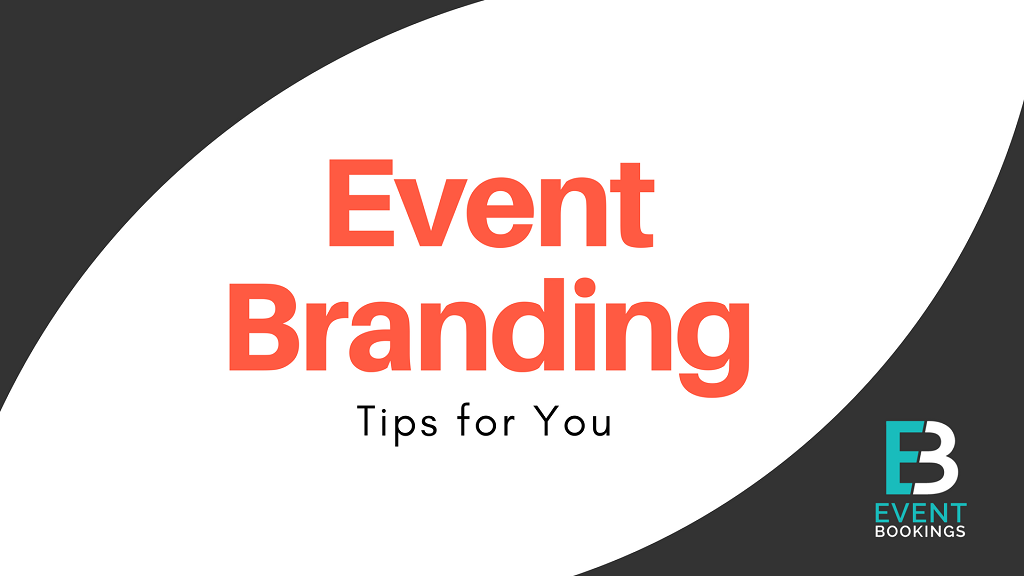When you hear the word brand, what comes to your mind?
A single or a set of attributes representing a company or the products/services a particular organization offers. A brand can be represented by a specific colour palette, theme, logo, design, symbol, or word.
In today’s highly saturated marketplace, event organizers need to establish their unique brands that can make a lasting impression on the attendees’ minds. Just like how we remember our favourite superheroes by their costume and symbols, we recognise brands by their logos, slogans, and the feelings they give us. For event organisers, standing out is like being the life of the party. They need a brand like a neon sign, shining bright and ensuring everyone remembers the fun. In a world of options, a brand is your golden ticket to being the star attraction.
This is why, as an event organiser, you must have some fantastic event branding ideas to make you stand out. Well, don’t worry if you are searching for ways like this. This article will discuss some of the most influential event branding tips that will be essential to your brand-building journey.
Before you begin (better not skip this section)
What is Event Branding?
Colours and logos are usually the first things that people consider when they think of event branding. There is a larger picture to take into thought, even though the significance of those two factors should not be understated.
Event branding can be thought of as the means through which a business or event communicates who they are. An organisation’s broader marketing strategy can be extended through event branding, which supports high-level goals like improving a company’s reputation, increasing brand recognition, and pursuing customer satisfaction.
Event branding strategy, to put it simply, is the marketing technique whereby a business or organisation develops a unique name, symbols, colours, messaging, and imagery to identify an event. Brand awareness events, thus has a set of branding strategies to incorporate into the specific event.
For instance, if a business prioritises personability in all of its marketing material, this would show in the branding of the event by making sure that all of the copy—from social media captions to signage—is personable.
Why is Event Branding Important?
Consider your event to be an immersive, whole experience. However, how would you and your team feel if your target audience couldn’t identify you as the event creator, regardless of how engaging they thought your event was?
Event branding is helpful in this situation. It can help your business grow and your event marketing’s long-term appeal by influencing how your sponsors, attendees, and stakeholders will remember your event.
For example, you can make your corporate event stand out from the competition, reach a great number of audiences, and host more successful events by developing an efficient corporate event branding strategy. It is essential to keep guests interested and produce experiences they won’t soon forget.
Benefits of Event Branding
In short, event branding is crucial because your brand is essential and should be promoted. Making a lasting impression isn’t enough; you also need to influence how attendees, partners, sponsors, stakeholders, and new customers view and recall your brand, which has a direct effect on the expansion and prosperity of your company. If you know how to create an event strategy but are wondering why you should create it, the following explains why event branding should be a primary concern:
1. Make an impression that lasts
Long after the event is over, your audience will still remember your brand, thanks to effective branding.
2. Set yourself apart from the competition.
Having a powerful and unique brand makes you stand out from the competition and makes you even the most popular choice.
3. Establish credibility and trust.
Your target audience will respect and believe in your event if you brand it consistently and authentically. Relationships are subsequently strengthened, and increased loyalty is encouraged.
4. Increase participation and attendance.
An event brand that is irresistible attracts more attendees, creates excitement, and increases engagement, all of which contribute to increased event success and participation.
5. Increase the size of your audience.
You can reach unexplored markets and increase event turnout by expanding your attendee base and drawing in new audiences through effective branding.
6. Demand premium prices.
A powerful brand conveys exclusivity and value, which enables you to market your event as a high-end experience and defend against higher ticket costs.
7. Encourage the expansion of your company.
Maintaining a consistent brand image across various occasions raises the value of your brand and opens up exciting new opportunities for business expansion.
The value of strong event branding
Even though it requires work, event branding serves a value. There are three ends in particular:
- Simplified, functional, and easy-to-follow user journeys to guarantee a flawless user experience
- Improvement of reputation
- Customer satisfaction
The way attendees describe their experience at the end of the day can be used to measure the success of your event branding.
In marketing, customer delight is all about going above and beyond for users. This is because exceeding expectations results in satisfied customers, who then become advocates. A business can benefit from word-of-mouth marketing in many ways, such as increased market authority and higher profits.
Guiding Principles of Effective Event Branding
Let’s explore the essential principles of effective event branding and how they play a part in the overall success of your event-
a) Event Branding Should Be Memorable
Your event needs to be visually striking and memorable in order to stick out in the minds of your target audience. You will lose out on a prospect’s full potential value and reduce the event’s potential long-term value if you are successful with one but not the other.
b) Event Branding Should Be Unified
All event branding components should work together to produce a seamless experience, from the initial announcement to the final item of merchandise. Make sure all of your touchpoints have a similar visual style because inconsistent design can subtly diminish the perceived value of your event.
c) Event Branding Delivers Stakeholder Value
Your most important people will connect your event with your exact value proposition if you have strong event branding. Over time, this relationship can help your company expand, raise Lifetime Customer Value (LTV), and strengthen brand loyalty.
How do you turn your event into a recognizable brand?
When promoting your brand through an event, you must clearly demonstrate what your attendees can expect from the event. Because, from content to conversation, everything needs to connect with people in a natural way. Ideally, you should let the brand tell your story.
Before jumping into the main course, please keep in mind these five branding elements –
- Authenticity
- Consistency
- Uniqueness
- Relevancy
- Emotion
Authenticity
With the voluminous cultivation of online and offline startups and marketing at the peak, audiences potential customers tend to filter out old, unauthentic, repetitive content both offline and online.
Since they get exposure to a lot of branding and promotional content, the only way to build and preserve your event brand connection and boost effective marketing gigs with your customers is to ensure 100% uniqueness, originality and transparency while tailoring your features and content.
Consistency
Once you ensure the originality of your event brand, you need to figure out the metrics to keep it consistent across all touchpoints. Brand consistency is basically a unified set of promotional, branding, and marketing expressions- with consistency.
Consistent stimulation of your event brand content to your potential customers will secure a lasting impression about your brand to them.
Eventually, these specific forms of content delivery in your words, offerings, design, perspectives and advertisements become identical and recognizable to the audiences and spread brand awareness.
Uniqueness
Suppose you want to set your brand apart from the competition. It’s about having something unique, distinctive, and memorable that makes your brand stand out. This distinctiveness can come from various aspects, such as your company’s story, how you deliver your products or services, or the value you provide. When your brand is unique, it’s more likely to catch the eye of potential customers and leave a lasting impression.
Your brand’s origin, history, and the story behind it can be a unique selling point. Sharing an engaging narrative about your company’s journey can help consumers connect with your brand on a personal level. What unique benefits or value does your product or service offer that others don’t? This can also be an essential element of uniqueness. Your logo, colour scheme, and overall design elements can make your brand instantly recognizable. A well-designed brand identity can set you apart in a crowded market. Last but not least, how you treat your customers, handle issues, and provide excellent service can also be a unique selling point.
Relevance
To make your event brand stand out, you need to dig into the metrics of your targeted customers. Predisposition or preference from a brand. Here’s where brand relevance becomes very important.
Not just unique and consistent, your event brand needs to give off a humane, relevant connection with your customers so that people can connect to your brand more emotionally. Regarding relevance, however, the biggest challenge is to collect, interpret, and effectively use the targeted customer journey data.
But once you get a grip on the customer journey, it will be much easier for you to drive the engagement and relevant point closer to the end of the transaction.
Organizing (or participating in) events is a very effective way to create better brand awareness and increase overall value. Your event must represent your brand, but it needs to have its own branding attributes, too.
Emotion
Emotion in branding refers to creating and nurturing a strong emotional connection between your brand and your target audience. It involves using feelings, moods, and sentiments to evoke a response or connection rather than relying solely on rational or functional aspects of a product or service.
Brands that successfully evoke emotions can build more profound, meaningful customer relationships. When people feel a positive emotional connection with a brand, they are likelier to become loyal customers and advocates. Emotional branding can help your brand stand out in a crowded marketplace. While many products and services may have similar features or benefits, the emotional connection can set your brand apart.
Brands must maintain a consistent emotional tone and message in their marketing and customer interactions. This ensures that the emotional connection remains strong over time. Emotion in branding is not just about making people feel good but about creating a lasting bond that goes beyond the functional aspects of a product or service. It’s about tapping into the deeper, more human elements of consumer decision-making and brand loyalty.
The event brand must have a distinctive personality and aesthetics that your prospects, stakeholders, distributors, and target audience can easily connect with without being too far apart from your organization’s branding properties.
The entire event branding can be categorized into two segments:
- Online Event Branding
- Offline Event Branding
In both cases, you have ways to make a statement with your event brand, ensuring a seamless and memorable experience for your attendees while leaving a lasting impression that extends beyond the event itself.
So, Let’s dig in and explore some practical and helpful event branding tips.
Online Event Branding Tips
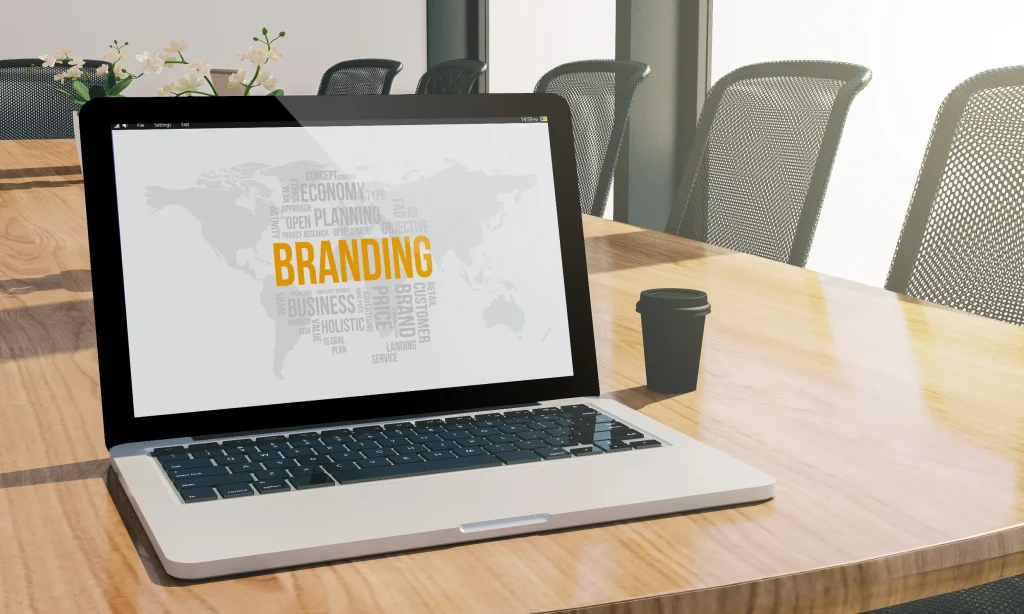
A successful event can be the most effective marketing opportunity to increase brand recognition among prospects. As the entire world is now connected via the internet, what better event branding tips can be practical other than online marketing?
Here’s how you can brand your events using online marketing strategies –
1. A consistent web presence
If you genuinely consider turning your next event into a brand itself, both online and offline, having a strong web presence has no other alternative.
Remember our earlier discussion on authenticity when it comes to assembling all your event components and turning them into a brand? That’s what happens when you decide to make a powerful web presence, which is through none other than an event-specific website.
Here are some stats for your better understanding –
- Web Credibility Research from Stanford states that 75% of a company’s credibility judgement is based on a company website. In other words, your event website serves as a doorway to your company and a virtual interface of your brand itself.
- Another research conducted by CXL states that it takes as little as only 1/10th of a second for online users to form a first impression about your event brand just by looking at your event website. This means the moment you have an eye-catching website for your event, the authenticity of your event as a brand is in the making.
Simply put, websites can do wonders for your event’s brand value more than any other implemented strategies ever did. No matter what your event is about, a website can generate goodwill among your potential attendees. And more prospects, and deliver brand marketing messages – whether your event is small, large or in-between, previously well-received or brand-new.
So, how do you make an event website?
Well, it’s very easy to design an event website these days with many ready-made templates, including built-in event booking features. But as our goal is to establish a brand for your event, just about any generic website will not do the trick.
Things you must consider while designing your event website are?
- Website Layout
- Theme
- Color
- Fonts
- Responsiveness
- User-friendliness
- Device friendliness
- Logo placement
Remember, the first professional presence of your event as a brand begins with your website. You don’t want to lose the opportunity to make an excellent first impression of your site’s uniqueness and how it reflects your brand’s core values.
And to get the maximum benefit from an event website you must think what message you want to deliver to your potential attendee, what will be your event brand statement, what will be your brand color? All these components will help you create the perfect event website for your brand.
2. Strong social media footprint
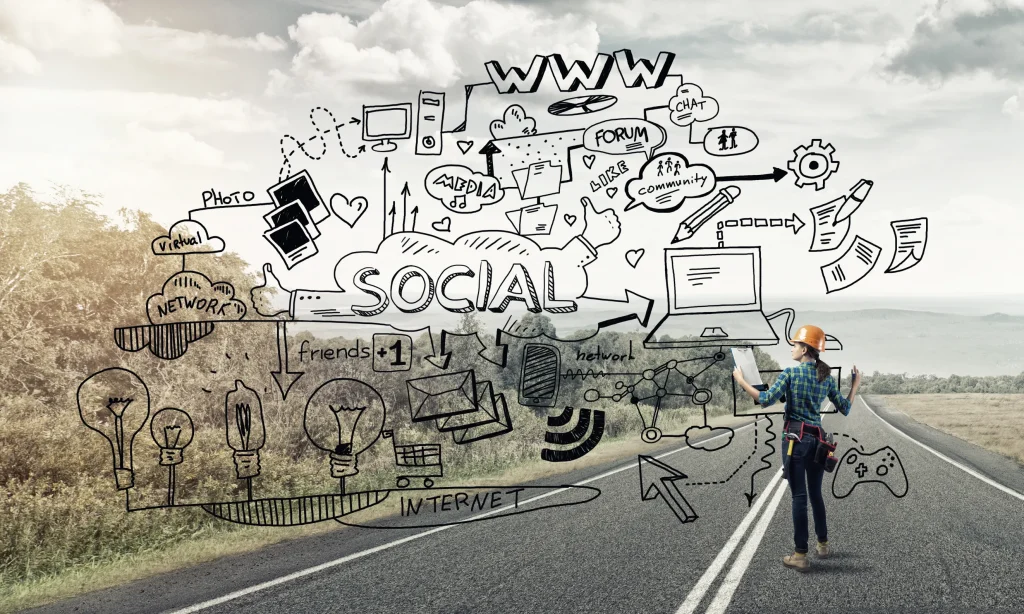
Once you establish your web presence, you must start working on your social media platforms. Social media and the web presence will solidify your event brand presence online more than you ever thought.
If your products/services are targeted at a younger population, then your event brand must maintain consistent appearances on the massively popular social platforms: Facebook, Twitter, Pinterest, Tumblr, YouTube, and various forums like Reddit, Quora, etc. You can also maintain an up-to-date event page to maximize the reach of your event brand to your potential attendees.
No matter what kind of event you’re organizing, consider utilising all of these social platforms to give your online branding complete coverage.
Creating a unique event hashtag can give you even more exposure. The regular appearances of your event name and brand logo on social feeds will subtly impact the potential attendees. Competitions and giveaways on social media are another way to get people talking about your event.
Remember that the more people talk about your event, the better it is for your brand. These platforms will also enable you to gather data to analyze for future reference, as you can track how many people are talking about the event or the brand online.
Here are some quick tips-
- Consistency is the key: Keep your logo, slogan, brand colors, business tones synchronized in all the social profiles.
- Website integration: It’s a must. Integrate your website with your social platforms to let visitors explore all aspects of your event.
- Tell a compelling story: Turn the idea of a brand into humane, attention-grabbing stories by spinning a yarn about it. Involve customers in a brand story, and they will engage with it.
- Make them visual: Add infographics, photographs and other visual images to posts and take advantage of Pinterest and Tumblr, which can be used to store and share visual content.
3. Use an official event hashtag
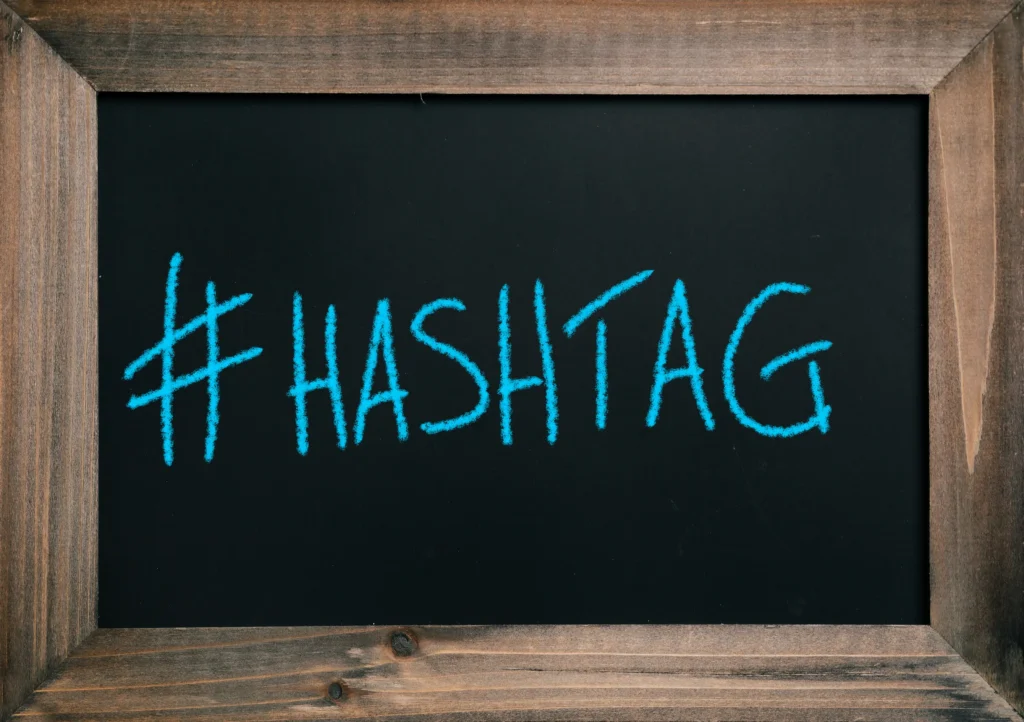
The official event hashtag is where your attendees will gather online to discuss every aspect of their experiences before, during, and after the event.
It is very difficult to incorporate a sponsor into the hashtag itself. It’s an enticing opportunity, to be sure, but it would more than likely result in a drop in overall engagement around the hashtag because of confusion.
As Mashable explains, the pound sign (or hash) turns any word or group of words directly following it into a searchable link. This allows you to organize content and track discussion topics based on those key responses.
Make sure your hashtag is visible at your event so your guests know how to use it. Include it in handouts and display it on screens throughout your venue. Better yet? Give people incentives to use your hashtag and share your event on social. This could mean setting up a photo booth branded with your hashtag or creating a photo competition where your hashtag’s best photo wins a prize.
For your sponsors to get the most value from the official hashtag, they should be made aware of the hashtag as early as possible to include it in their messaging and to give them an opportunity to engage organically with attendees before, during and after the event.
- Boosts brand recognition very quickly
- Can easily turn into a searchable link for social media site visitors
- Helps to create online communities
- Makes spreading online event content and updates easier
- Keeps your social profiles upgraded and engaged by participants
4. Email marketing
Email communication plays a vital role when it comes to communicating with your potential attendees, guests, and sponsors.
Building up communication is easier and faster than any other communication channel. According to digital marketers, it has also proven to be the most effective method of brand promotion.
So, once you build up the email communication channel, you can use email marketing techniques to promote your event brand. Try to make your email layouts and designs have aesthetic appeals (logos, fonts, colours, language tones) similar to your website. This will create a cohesive web presence for your event brand.
Related: List of email marketing tools to promote your events
5. Paid campaigns
Once you have your event website, active social media channels, and email marketing list, start running paid campaigns on various social media platforms or internet advertising, such as Pay-Per-Click (PPC), to direct traffic to your event page.
You must allocate more budget for this as it’s more expensive than other strategies. However, in most cases, the return is worth it.
Here are some key points that you must keep in mind to ensure your paid campaign upholds your event brand image:
- Always add an end date to your PPC campaign. Event organizers often make this mistake, so the event ads get displayed even after the event ends. This looks unprofessional and harms your brand image.
- Add countdown dates to your event advertisements. Customizing online ads to show an automatic countdown leading to the event date is easy. This will create a sense of urgency among the viewers, who will be interested in knowing your event better.
- Facebook ads are very effective for creating faster brand awareness about your event. Aiming your event page, targeted Facebook ads will take your event branding efforts to a newer height by reaching audiences likely to participate.
6. Influencers and attendees as brand advocates
Last, but not least, try to collaborate with social influencers. Trust us, it works!
Most influencers are more or less brand advocates. It’s all part of their act. They have a loyal follower base that could be a great channel to share content and spread the word through social media or word of mouth.
You can ask your influencers to share personal pictures of themselves engaged in activities related to your brand. They could share a live feed or share stories to document their experiences.
Not only should they share content about the event once it ends, but they should also share content during the event to let their followers in on the experiences.
Offline Event Branding Tips
Most of the online branding ideas that we’ve discussed earlier are mostly part of pre-event preparation.
Not only should they share content about the event once it ends, but they should also share content during the event to let their followers in on the experiences.
1. Solid brand visibility
Many pundits consider Apple Inc. as the most successful brand in the modern era. This giant company holds regular events to announce new products, innovations, and technologies.
All these events bear striking resemble the brand’s aesthetics and also have their own distinctive flavours that make these events fun and exciting experiences for the attendees.
Taking a page or two from Apple’s strategy (wouldn’t hurt, would it?), first, you need to select a theme for your event that reflects your organization’s values and visions. But we must remember that the event could also feature its branding. The venue design, decoration pieces, motifs and themes, using the logo as a part of the decoration? All should perfectly align with your event and organization’s brand. So, when the attendees walk into the event location, they will instantly be transported inside your brands.
Here are some quick ideas for showcasing your brand (elements) during an event –
- Banners, posters, leaflets
- Photobooths
- Merchandise for both attendees and guests
- T-shirts
- Handy stationaries
- Scratch cards, voucher cards
- Food and beverages
Read more: 10 branding lessons from Apple that can turn the tide for you
2. Interactive kiosks
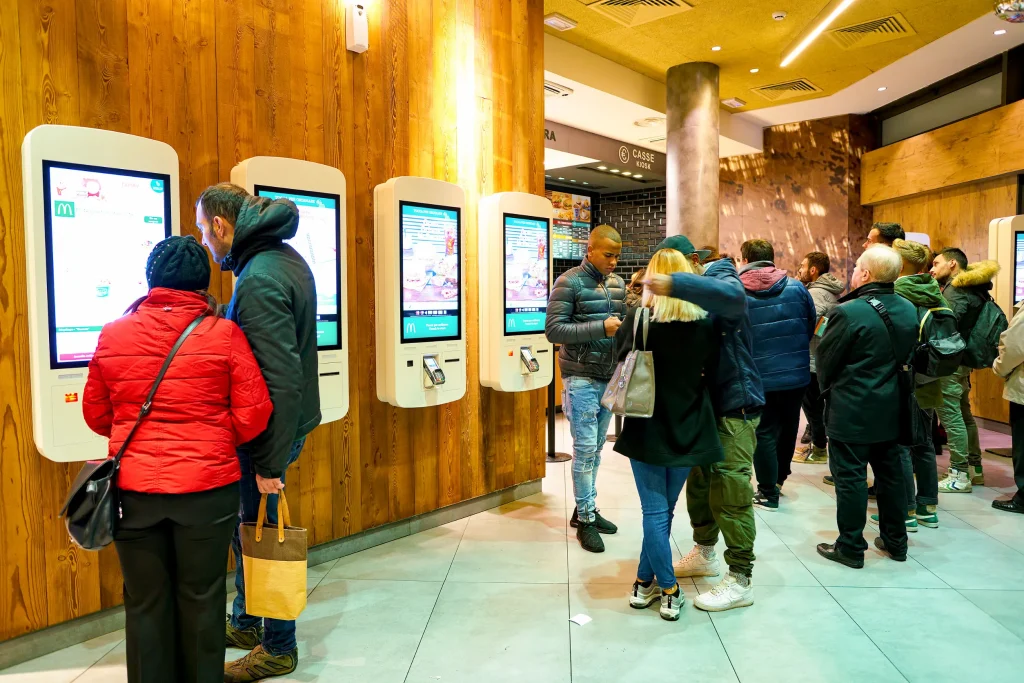
If your event holds a significant number of attendees and is located in a high-traffic venue, renting an interactive kiosk can be a great on-spot event branding tool.
You can customize the information, application, navigation details, images and other exclusive event brand-related features you want to provide your attendees.
There are many types of kiosk machines that you can use in your event: touch-screen kiosks, internet kiosks, vending kiosks, self-service kiosks, and photo kiosks. Depending on your event type, select the right kind of kiosks.
Renting a kiosk and customizing it for your event can be a bit pricey but well worth it if you can squeeze it into your budget. Include some game or interactive feature related to your brand. Upon successful completion, the participant receives a voucher they can redeem for promotional gear.
Here is how renting an interactive kiosk can help your event –
- Leverages your attendees’ self-service experience
- Assures more improved attendee experience
- Reduces overall event management cost
Suitable events for kiosks:
3. Real-time social media walls
With a real-time social media wall at your event, you can instantly take the extent of audience engagement to the next level. A social media wall is basically one or multiple screens that help you share your live social media activities with the audience and let them engage and participate.
On top of that, using social media can also empower attendees and let you magnify the impact of your event brand at the same time. Most importantly, these social media tools for live events can help you with numbers, figures, reports and analytics of repeatable ROI for your events.
- Effectively reaches out to your target audiences
- Helps to enrich your content strategy
- Provides good deals and great value to your audience
- Quickly builds trust among the audiences
- Helps improve Brand Awareness
- Builds winning partnerships and sponsors
- Helps you diverge networks
Suitable events for real-time social media walls:
4. Interactive graffiti walls
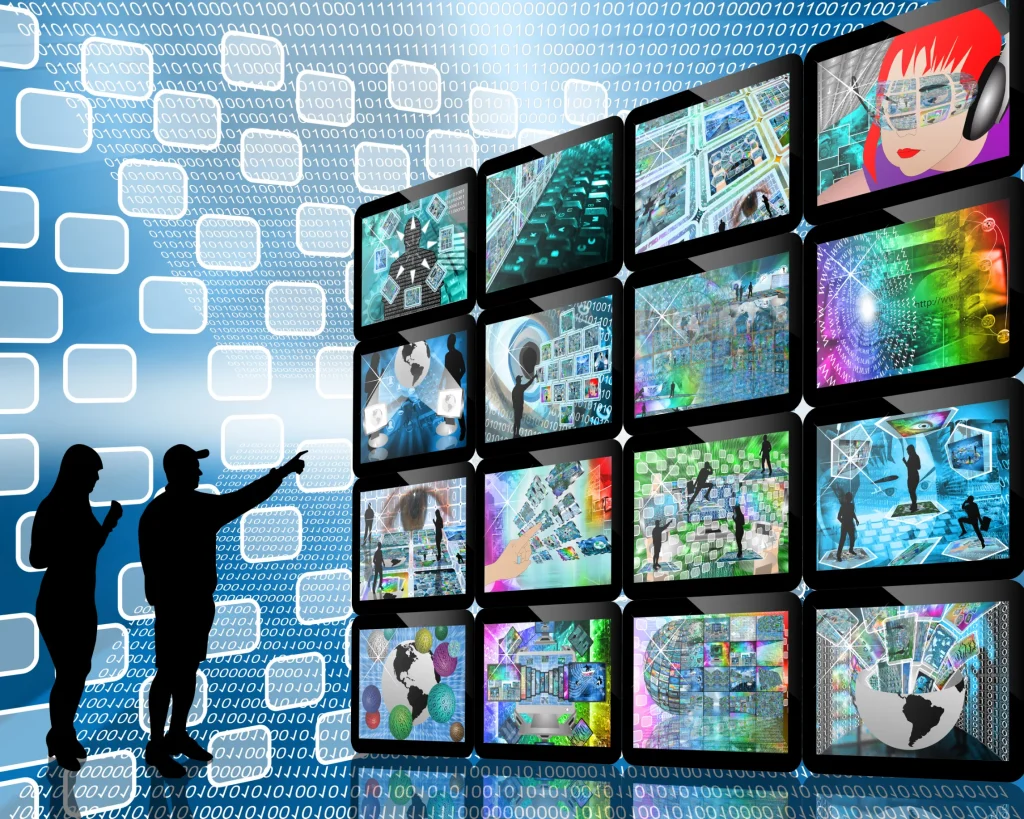
Digital graffiti walls can be a WOW factor for flaunting photographic features, displaying event information and branding, etc.
Basically, a graffiti wall is a highly portable station with compelling software to elevate any event experience to the next dimension.
Moreover, these graffiti walls and digital artistic tools allow you to share the illustrations made by the attendees on social media instantly!
Creates an interactive environment with easy social media sharing for attendees
Goes perfectly for events like exhibitions, trade shows, award ceremonies and corporate events
Makes customized stencils & branded covers for individual events.
Suitable events for interactive graffiti walls:
5. Gamification participation
To enhance the brand value of your event, gamification almost has no other alternatives.
Simply put, gamification is a customizable on-spot game plan for engaging the event attendees using various gaming mechanics.
Unlike any other gaming skits, gamification enables very much event brand-oriented activities. In other words, gamification transforms event models into multiple levels of gaming schemes for attendees to drive engagement and customer loyalty.
Just incorporating your sponsor contents into the game plan, you can facilitate both attendee engagement and sponsorships.
The best thing about structuring gamification is that it can easily be integrated with all the latest event technologies and schemes like social media leaderboards or scavenger hunts. For instance, event gamification in event apps can spare you a reasonable amount of time planning and incorporating the schemes during the live event.
Here are some of the benefits of event gamification-
- Generates event ROI and revenues
- Facilitates easy and effective communication with the audiences
- Turns attendees into proactive, enthusiastic participants
- Makes a scope for crowdsourcing
- Boosts on-spot engagements with sponsors and exhibitors
- Takes attendee experience to the next level
Suitable events for event gamification:
6. Audio-visual Branding:
Audio and visual branding are important offline components of your event’s overall brand identity and experience that work great, among other event branding tips. It uses sound and visuals to create a consistent and engaging brand presence. Here are some key aspects of audio-visual branding for events:
- Introductory Videos: Consider starting your event with an introductory video that encapsulates the event’s theme, purpose, and values. Use music, imagery, and messaging that align with your brand.
- Custom Soundtracks: Choose background music or soundtracks that reflect your brand’s tone and mood. The right music can enhance the atmosphere and create a more immersive experience.
- Branded Visuals: Design branded visuals, such as opening and closing animations, speaker transitions, and event graphics that incorporate your event’s logo, color scheme, and messaging.
- Lighting Design: Use lighting to reinforce your brand’s visual identity. This can include lighting effects, color schemes, and dynamic lighting changes that reflect your brand’s personality.
- Audio Effects: Integrate sound effects or audio cues that align with your brand. For example, consider using signature sounds for announcements or transitions.
- Interactive Presentations: Encourage speakers to use visually appealing and on-brand slides in their presentations. This can include using consistent fonts, colors, and imagery.
- Stage Design: Ensure the stage design and backdrop align with your event’s branding. This includes using banners, signage and displays that showcase your logo and messaging.
- Video Content: Use video content, such as interviews, testimonials, or promotional videos, that incorporates your event’s branding. This content can be played during breaks or intermissions.
7. Uniformed staff
Staff wearing the same uniform at an event play a vital role in reinforcing the event’s branding and ensuring a cohesive and professional atmosphere. These staff members, including event organizers, volunteers, ushers, security personnel, and event hosts, wear uniforms that are specifically designed to align with the event’s brand identity. These uniforms typically incorporate the event’s logo, colors, and messaging, creating a visual connection between the staff and the event itself.
Uniformed staff enhance the event’s visual consistency and serve practical purposes. They help attendees easily identify event personnel who can provide information, assistance, and guidance. The uniforms also convey a sense of authority and professionalism, instilling trust and confidence in the event’s organization. This, in turn, contributes to the overall guest experience, as attendees feel assured that they are in capable hands. Uniformed staff are not just representatives of the event; they are a fundamental part of the event’s branding strategy, contributing to a cohesive and well-managed experience that attendees are likely to remember and associate with the event’s success.
8. Feedback and Surveys:
Collecting responses can be a valuable tool for offline event branding. Set up feedback stations at strategic locations throughout the event venue. Attendees can provide their input by filling out printed feedback forms. Ensure that these forms feature your event’s branding elements, such as the logo and color scheme. Design branded feedback forms in advance and provide them to attendees in their event materials. These forms should include questions about various aspects of the event, such as content, logistics, and overall experience. This is an essential step because Collecting feedback in a structured way reinforces your brand’s professionalism.
Consider using interactive audience response systems or mobile survey apps that attendees can use on their smartphones or provided devices. Ensure these digital surveys reflect your event’s branding by using your logo and colors. Also, Use event breaks as an opportunity to actively collect feedback. Have event staff or volunteers approach attendees to ask for their input. Lastly, Create a physical feedback wall where attendees can post sticky notes with their comments and suggestions. Design this wall to be consistent with your event’s branding.
The three most common branding strategies are:
Corporate Branding: Targets the overall image and values of the organisation.
Product Branding: Centres on promoting a specific product or service.
Personal Branding: Builds the reputation and image of an individual, often aligned with their expertise or influence.
Establishing a consistent and favourable perception of the business in the eyes of stakeholders, such as clients, staff, and investors, is the main objective of successful corporate branding. It seeks to increase loyalty, establish trust, and set the business apart from its rivals.
Generally speaking, a brand’s personality reflects its emotional tone, target audience preferences, and core values. It frequently fits with human qualities like being dependable, creative, or playful, which facilitates a deeper connection with customers.
Wrapping up
Events are ways in which you can create psychological and emotional connections with the participants. Event branding does not just strengthen the relationship but also sustains it in the long run. The benefits of event branding don’t end with the event.
According to your event type and objective, try the event branding strategies discussed above. You’ll find that the opportunities are endless, and you may develop your own branding strategies.
Just remember to use all the accessible mediums to reach out to your target niche and create thriving brand awareness. Strong event branding will help your future events become more popular and successful.
